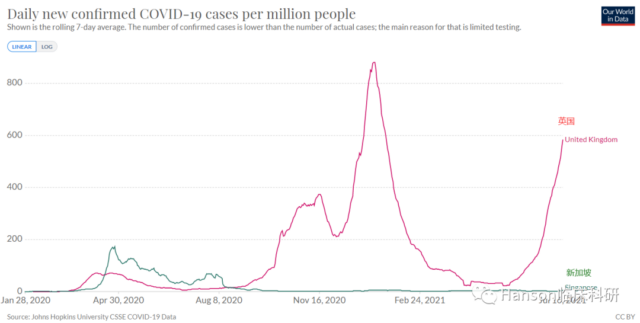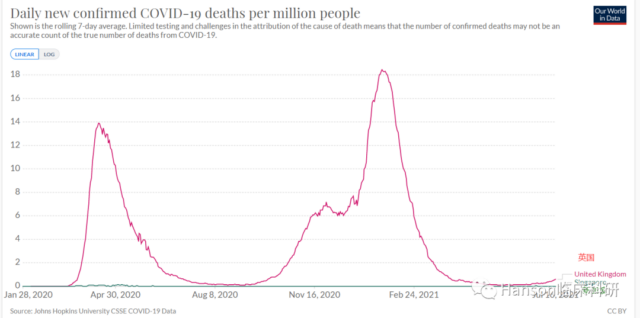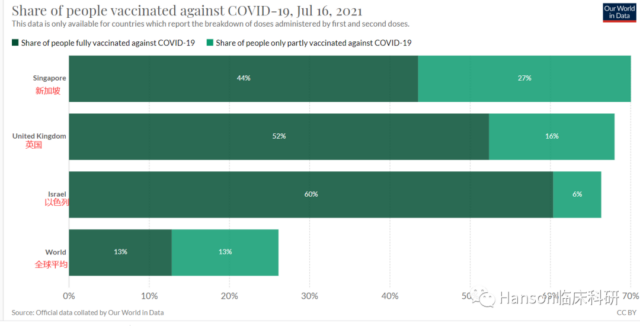Britain and Singapore use quite different roadmap for “coexist with COVID-19”
- A Single US$2.15-Million Injection to Block 90% of Cancer Cell Formation
- WIV: Prevention of New Disease X and Investigation of the Origin of COVID-19
- Why Botulinum Toxin Reigns as One of the Deadliest Poisons?
- FDA Approves Pfizer’s One-Time Gene Therapy for Hemophilia B: $3.5 Million per Dose
- Aspirin: Study Finds Greater Benefits for These Colorectal Cancer Patients
- Cancer Can Occur Without Genetic Mutations?
Britain and Singapore use quite different roadmap for “coexist with COVID-19”
Britain and Singapore use quite different roadmap for “coexist with COVID-19”. The new coronavirus pandemic has been more than a year and a half, and vaccination has lasted for more than half a year.
Humankind’s attitude towards COVID-19 is becoming more and more rational: the new coronavirus will not disappear in the short term, but the hospitalization and mortality rate of vaccinators after infection is extremely low.
In short, for vaccinators, the new coronavirus infection has become more and more like a pandemic.
Reopening and returning to normal life have become the current theme. In this regard, the United Kingdom and Singapore are ahead of other countries. However, the roadmap for its implementation is quite the opposite, which is of immense reference value for other countries.

(According to the population ratio, the new cases in Singapore and the United Kingdom change)
Let us first look at the history of the epidemic in the UK and Singapore.
Britain is a big country with 66 million people, while Singapore is an island country with only 5.69 million people.
At the beginning of the epidemic, Singapore quickly closed its borders, adopted strong government control, and implemented a comprehensive contact tracing and testing program. As a result, Singapore quickly controlled the spread of the COVID-19 virus, and it has been under control since September 2020.
In contrast, Britain is a mess. From the beginning of the 2020 epidemic, the British government has been widely condemned for its slow actions in implementing control measures (such as mandatory wearing of masks and blockades, etc.). The result is also clear at a glance. The UK is one of the countries with the highest number of COVID-19 cases and related deaths in the world. In the past two months, the number of COVID-19 cases in the
UK has surged again, and there is no trend of abating.
The fluctuations of the two countries’ epidemics can be seen from the fluctuation chart of new cases below.
Why are two countries with such different control measures and epidemics adopting similar open goals-to accept the COVID-19 virus?
Because of the vaccinators, the number of deaths related to COVID-19 has been very low.
Although 129,000 people have died of illness in the UK, and the number of new cases is still increasing; the number of deaths from COVID-19 has not changed much in the past three months. This means that vaccination adequately prevents the infected person from developing to a critical condition.
The COVID-19 fatality rate in Singapore has been extremely low, with only 36 people dying from COVID-19.
It can be seen clearly from the picture below.

(According to the proportion of population, new cases and death changes in Singapore and the United Kingdom)
Open road map
Although both the UK and Singapore have decided to accept the long-term existence of the COVID-19 virus, the specific implementation strategies are quite different.
In June 2021, Singapore’s “New Normal” road map released shows that Singapore is prepared to completely abandon the previous “zero input” model; instead, the infection monitoring of the new coronavirus is shifting to result monitoring. That is, we only pay attention to how many cases of COVID-19 are seriously ill, critically ill, and dead.
Just imagine, if after vaccination, the infection of the COVID-19 virus is not as harmful as the flu, will it be necessary to continue to lock down the country?
British Prime Minister Johnson’s remarks after Singapore were similar to those in Singapore. He predicted that “COVID-19 will become a tolerable virus, just like the flu.” As a result, the UK will lift all restrictions on the COVID-19 virus on July 19.
But unlike Singapore’s policy, which has been unanimously supported by the people in the country, Johnson’s plan has again been widely questioned. On the one hand, there are nearly 40,000 new COVID-19 infections in the UK every day. It is also because there are still 17 million people in the UK who have not been vaccinated against COVID-19, including children aged 12-17.
From the starting point, the goals of Singapore and the United Kingdom are quite different.
Singapore’s main goal is still to persist in eradicating the COVID-19 virus, and the government is still taking the main responsibility.
The UK is lying flat again. The main goal is not to eliminate the COVID-19 virus, but only to “not significantly increase disease and death”; to abandon government responsibility and let individuals be responsible for themselves.
When the main goals are different, the measures taken are naturally different.
In the UK, regardless of the rapid increase in infection cases, as long as the number of deaths does not increase.
Singapore, on the other hand, “maintained a balance between virus containment and deregulation” with few local cases.
Therefore, Singapore does not have a clear timetable. Instead, it adopts “crossing the river by feeling the stones”, step by step, and every step must ensure the safety of the people.
Deep reasons for adopting different roadmaps
We start with the public support of two policies.
Singapore’s road map has received little public opposition. The people have a high degree of trust in the government, and the government they trust has indeed effectively contained COVID-19 in the past year or so.
In contrast, the United Kingdom has been controversial since the beginning of the epidemic; it seems that it has always been based on the latest scientific evidence, but it has been restricted by humans’ limited
understanding of the virus and the epidemic.
The two countries adopt different road maps, and the deeper reason is the government management system.
Despite being fully Westernized, Singapore has always had the characteristics of an authoritative government unique to East Asian countries. The big government has a series of strict and top-down rules. At the same time, the people also agree with the measures of this authoritative government and voluntarily give up some personal rights. In particular, strictly abide by the government’s key measures such as “wearing masks, gathering the number of people, and opening public places”, and the public has almost no resistance in their implementation.
The United Kingdom, as the country that is best at compromise and at the same time respects human rights, in the face of the pandemic, the government has always been unable to restrain the people.
After all, it’s the human right or human left dispute.
For scientific researchers, we prefer actual data; therefore, we use the vaccination situation to show the compliance of the two countries to government policies.
The United Kingdom approved the vaccines of AstraZeneca and Pfizer in the first time, and vaccinated them quickly; however, some of them resolutely refused to vaccinate, so the vaccination was weak in the later period.
This situation also exists in the United States, Israel and other countries.
Singapore finally ushered in a sufficient supply of vaccines after waiting so long. The people are very willing to vaccinate, and the current proportion of the vaccinated population has surpassed that of the United Kingdom.

(Proportion of population vaccinated)
In the context of the pandemic, the executive power of Singapore and the British government is very obvious, and the results of epidemic prevention are naturally completely different.
In addition to the huge difference in the road map and the reasons behind it, we want to know what is behind the similar understanding of “symbiosis with the virus” adopted by Singapore and the United Kingdom.
What supports the decision of the United Kingdom and Singapore to coexist with the COVID-19 virus is the vaccination rate of the two countries.
According to the proportion of the vaccinated population, they have surpassed the model student Israel and far higher than the global average.
Singapore’s Minister of Health predicts that 80% of the country’s population will be vaccinated. With such a high vaccination rate, the use of highly protective vaccines, and the people are also paying attention to the prevention of the new coronavirus, Singapore naturally has the confidence to “symbolize with the new coronavirus.”

(source:internet, reference only)
Disclaimer of medicaltrend.org
Important Note: The information provided is for informational purposes only and should not be considered as medical advice.



